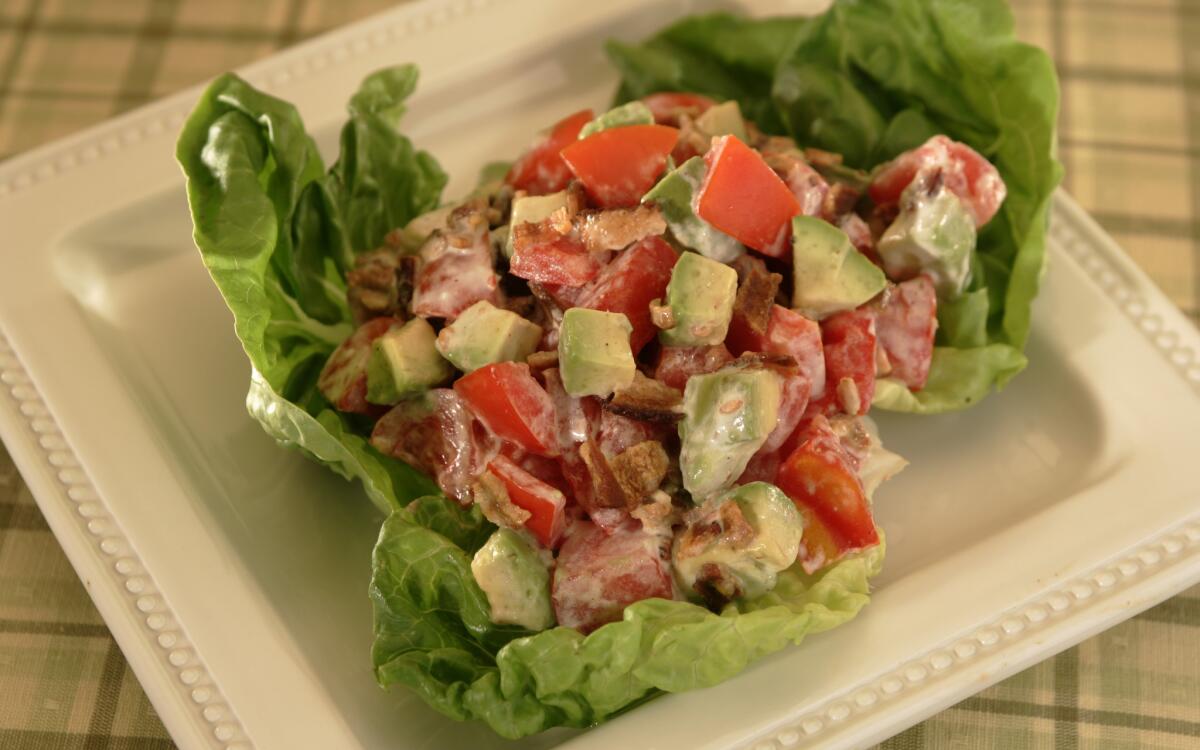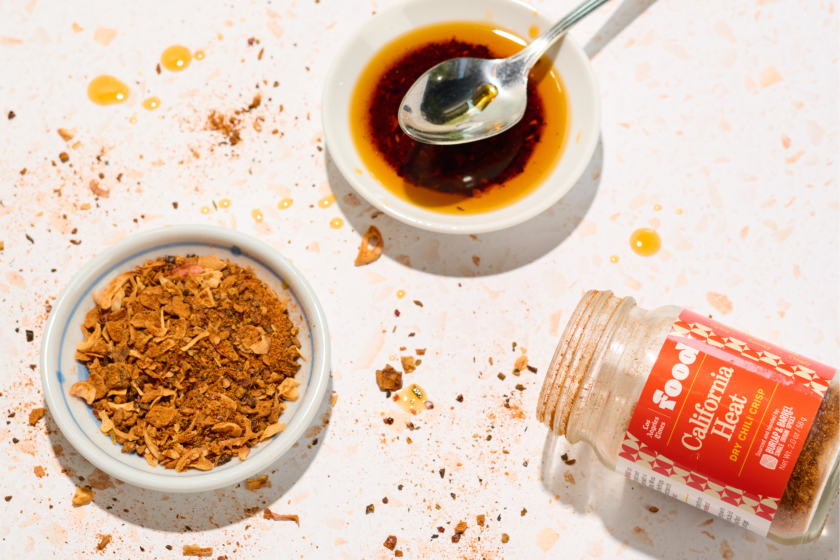Tomato-bacon-avocado salad

Like any old reader, I don’t take well to change. But there’s redesign and then there’s desecration.
When I opened a recent Taste of Home, America’s most reliably gritty food magazine, it had been invaded by a glossy opening spread of slick food, a table of contents, much more white space and, worst of all, a big photo of a picnic straight out of Bon Appetit or any other glossy magazine, every shining happy person around the table far too coiffed and costumed to be real.
Did the world really need another Food & Wine?
There’s a reason Taste of Home is the most popular food magazine in the country, maybe the world. It’s the perfect antidote to faux trendiness and wine-upmanship and kitchen makeovers indistinguishable from GE Profile ads. Because it carries none of the usual advertising suspects, it is also free to show home cooks as they really are -- Cool Whip, obesity, kitsch overkill and all. Readers eat that stuff up because they can get it nowhere else.
Until now.
Another publisher has apparently decided that what the world really needs is another Taste of Home. The new Cook’s Country -- from the people behind Cook’s Illustrated -- borrows so heavily from the down-home original that it took me a while to realize most of the recipes, and all of the copy, are generated not by “a thousand country cooks,” as Taste of Home boasts, but by a serious staff. And I do mean serious.
There’s much to be said for that if you’re interested in cooking more than in amateur sociology. Massachusetts-based Cook’s Illustrated is renowned for being the antithesis of food porn, with its relentlessly grim dedication to finding the ultimate macaroni salad or corn fritter. The kitchen crew there can take the most seductive recipe on the planet and turn it into something as exciting as the manual for a DVD player. To say they brook no nonsense would be as much of an understatement as asserting that Gourmet romanticizes travel.
But it does mean that the recipes work, and well enough to be fit for company, and that holds especially true with the spinoff. You might want to be a little more lascivious with the seasonings, especially salt and spices and herbs and garlic, but a skillet lasagna will produce exactly what the editors promise: the layered effect of the baked original with about a tenth of the effort.
With Taste of Home, you have to study the photo that accompanies every single recipe, first to be sure it might be worthy of a halfway sophisticated palate and second to figure out the steps of preparation and presentation that the instructions tend to shortchange (the grated potatoes for a cheese-filled appetizer need to be shaped into little baskets, for instance).
Relying on ‘real’ cooks
Recipes in Cook’s Country tend to be minimalist in a very modern way -- tomatoes, bacon and avocado make a salad with a lightened-up mayonnaise dressing, the whole so much more than a BLT without the bread. Taste of Home generally goes for baroque, intended as it is for cooks who fire up the stove for love and throw their all into every single dish: Potatoes are just not done until they are combined with cheese, bacon, sour cream and butter.
But it is in the reliance on “real” cooks that the two magazines both come together and diverge. The first few pages of Cook’s Country showcase recipes allegedly from readers, the kind who feel compelled to enter contests for $500 and less. Taste of Home uses nothing but unpaid contributions in return for the milliseconds of fame a photo, hometown and maybe a bit of bio bring. Yet judging by the last two issues, the winners at Cook’s Country, even those showcased on the cover, bear no more similarity to Bon Appetit models than Taste of Home’s do.
Cook’s Country has a much cleaner style than its apparent inspiration, even though Taste of Home has been gradually slithering toward polished ever since the Reader’s Digest Assn. bought its publisher, Reiman Publications of Greendale, Wis., in 2002. (Sunset magazine went through a similar mainstreaming phase after Time Inc. bought it but eventually reverted to its strong Western look and bias.) Taste of Home’s circulation is reportedly more than double that of Cooking Light, the largest mainstream food title with 1.7 million readers.
With Cook’s Country, the typeface is just retro enough to be reassuring to the Gourmet-fearing but not quite as unnerving as in James Lileks’ ode-to-the-Eisenhower-era “Gallery of Regrettable Food.”
But the copywriting, especially the recipe titles, makes my mom’s 1950s Betty Crocker cookbook read like Hemingway. Polka-Dot Minty Melon Mold should give you a hint (neither magazine is afraid of gelatin), and if not there are always tomato salads, starting with It’s All Greek to Me and ending with Rhapsody in Blue Cheese, but not without a stop at Fit as a Fennel. Slaws are sassy, salmon is zesty. Readers, however, are not dummies.
Cook’s Country’s newsy feature in which “readers tell us what’s cooking in their communities” is like a Saveur hybrid, with amateurish-looking photos combined with copy clearly refined in-house.
“Ask Cook’s Country” is very similar to many features in Taste of Home, but then it is also a riff on what Cook’s Illustrated does so well in imparting technical information. Cook’s Country emulates Cook’s Illustrated in reviewing equipment such as blenders and knives, while Taste of Home merely shows kitchens made over in all their glory. Both magazines also have illustrated clip-and-save recipes at their core.
Cook’s Country may be hoping to take a big bite out of Taste of Home’s readership, but I wonder. I first came across a well-thumbed copy in the kitchen of my mother-in-law equivalent, who gives me a subscription to Taste every year. She’s not abandoning her old favorite, but I could see her signing us both up for the knockoff -- six issues of either cost about $20 a year. And if she doesn’t, I will.
After all, both magazines seem intended as much for armchair cooks as for apron wearers. Each is packed with tiny bits of type, like blogs gone wild, and each shows every dish in case any vicarious eaters are reading in. Taste of Home even crams its margins full of extras, with little sayings along the lines of “Food for Thought: A balanced diet is a cookie in each hand. -- Unknown.”
Last month, those quirky tidbits were absent from the attempted redesign. In the just-out August issue, they are back. An unsigned confession on the masthead page says they were restored after “your letters and e-mails said they are a friendly element that makes Taste of Home different from other food magazines.”
No mention was made of the too-sunny-morning-in-America party picture, that bit of sameness from other food magazines. It has now gone missing, and that is probably the best sign that Taste of Home might be able to fight the good fight against alternative “reality.”
Whisk together the yogurt, mayonnaise, milk, garlic and salt and pepper in a small bowl.
Place the tomatoes, avocado and bacon in a large bowl and pour the dressing over. Toss until evenly coated. Adjust seasonings.
Line a serving bowl with lettuce leaves and fill with salad. Serve.
Get our Cooking newsletter.
Your roundup of inspiring recipes and kitchen tricks.
You may occasionally receive promotional content from the Los Angeles Times.













